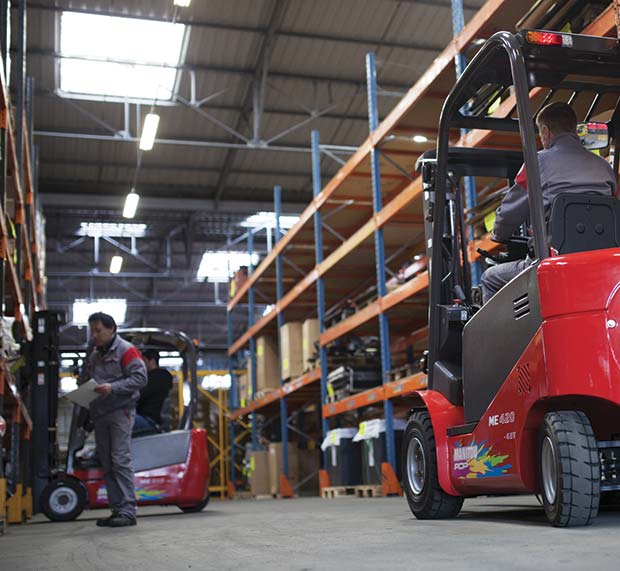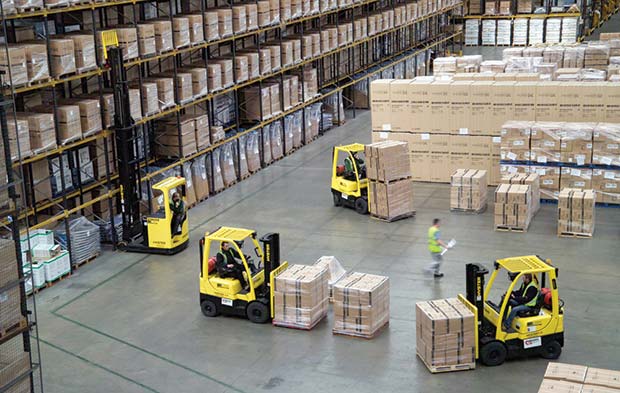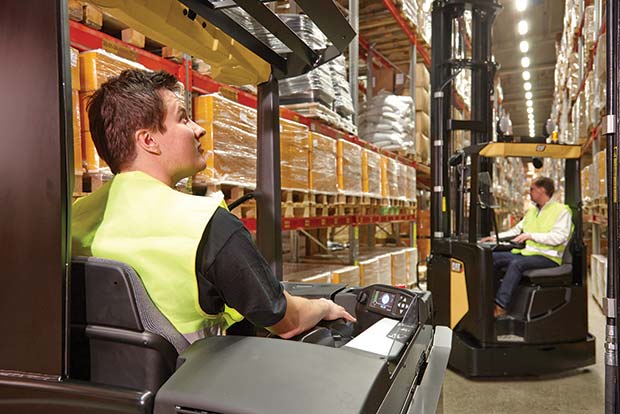FLTA chief executive Peter Harvey discusses the tough decisions facing electric fork lift truck users.
 Not so long ago, power choices for fork lift truck users were fairly cut and dry, with options for diesel, LP gas or lead-acid battery power. In recent years, emerging technologies, such as lithium advances and hydrogen fuel cell, have widened our choices.
Not so long ago, power choices for fork lift truck users were fairly cut and dry, with options for diesel, LP gas or lead-acid battery power. In recent years, emerging technologies, such as lithium advances and hydrogen fuel cell, have widened our choices.
We are all attracted by the promise of new technology, but the best or most appropriate power source for your equipment should depend on your application, followed by your budget. There will be health and safety implications whichever power source you use, so it’s important to consider those, too.
Our guide highlights some of the advantages and disadvantages associated with each of the more ‘traditional’ motive power choices, as well as the newer technologies available.
Diesel
A truly flexible workhorse, the diesel forklift is ideal for outdoor use or indoors in some applications. The diesel truck will be cheaper to fuel than LPGs, particularly when the user already has diesel fuel on site.
Cheaper to purchase than electric trucks, they are relatively easy and cheap to maintain and quick to refuel. Perhaps most importantly, they offer a long life with good residual value.
But this powerful performance comes at an environmental cost. Its exhaust fumes mean it isn’t as suitable for indoor use because of the fume and particulate hazards. However, the presence of particulate filters mitigate the problem somewhat, making diesel trucks appropriate in a wider range of applications. Diesel trucks can be noisier and bulkier than other truck types. They also require greater operator skills than electric trucks.
For employers, they raise safety issues around the storage and security of fuel – including clean up after spills – as well as a hot exhaust risk. On some models productivity can be lost while the operator waits until the particulate filter is clean.
LPG
Gas trucks are the cheapest to buy and have several advantages over diesels, such as, quieter operation and significantly reduced air particulates making them suitable in many instances for outdoor and indoor use. The fitting of a three-way catalyst means virtually zero carbon monoxide and hydrocarbons. There are, however, some drawbacks. Gas trucks can create fume and/or smell issues and the cost of fuel and maintenance are relatively high. Refuelling can also be trickier as the lack of a fuel gauge may create a problem. For those operating LPGs, there are safety considerations, including fume hazards in confined spaces (eg containers); storage and security of fuel and hot exhausts.
 Electric (General)
Electric (General)
Ideal for indoor applications, electric trucks are very environmentally friendly. During operations they produce no emissions and they’re quiet to run (although this could be a hazard in some environments). They’re highly manoeuvrable and the easiest truck type to operate.
In terms of costs, they’re more expensive than IC engine to buy, but are cheaper to service and maintain (usually delivering lower whole-life costs when judged over a five-year term).
Electric trucks demand a dedicated, well ventilated area for charging and in multi-shift operations management will also need to factor in the cost of additional batteries along with the man hours required to perform battery swaps. Employers may also need to consider the impact of power cuts.
Traditionally, they offered limited scope for operations outdoors and required a good operating surface though a new breed of robust, water and weather resistant models are blurring the lines between IC and electric performance.
Safety can be an issue. Every year, at least 25 people are seriously injured when using batteries at work. Hazardous fumes created during battery charging are a danger. HSE’s INDG139 (Using electric storage batteries safely) offers guidance on the subject. In addition, your battery supplier should provide safety instruction and your staff will require training and PPE If manually toppingup a battery.
Widening battery choice
Fork lift batteries are expensive. In fact, your battery can be worth more than 20% of the machine’s total value but it is effectively your fuel source for your next five years. As such, it’s really important that you make sure you get the best ‘mileage’ from it…
In recent years, we’ve seen the choices of batteries – for fork lifts, as well as everything from mobile phones to cars – widen with the introduction of lithium technology. The use of batteries has long featured in the materials handling industry in marked contrast to the automotive sector. The latter, though, has been quicker in adopting lithium technology.
Here’s why:
There’s a special relationship between lead-acid batteries and electric counterbalance trucks. They have a somewhat symbiotic relationship that is best illustrated by looking at modern electric truck design: it continues to rely on the battery to serve as counterweight. While lead acid has been around for more than 100 years, lithium is a newcomer to the materials handling field. Unlike lead acid counterparts that are tried and tested, it’s a stilldeveloping technology.
Indeed, there are several types competing in the market – including lithium-ion, lithium-iron and ironphosphate. The difference between them is found in the stability and the cycle life (energy density) and this is reflected in the price.
 Maintenance and charging
Maintenance and charging
It is the potential for opportunity charging that makes lithium so attractive. Because trucks can be charged as and when necessary – without harming the battery – employers may be able to shrink the size of their fleet.
But, this may not necessarily save time or money because some of these batteries will still need a lengthy charge to reach 100% and trucks benefitting from this technology do come with a much higher price tag. It can be four-times more expensive to install than lead acid batteries but in hard applications the whole-life costs could outweigh this expense.
Maintenance is another draw for truck users as it significantly reduces the need for daily or weekly maintenance. In fact, lithium-iron phosphate technology claims to offer 8 – 10 years of service – with no requirement for daily or weekly maintenance: saving time and money.
Environmental considerations
Lead-acid batteries have a bad reputation in this area, thanks to the presence of relatively rare precious metals that are toxic to us and the environment. However, lead-acid batteries are 99.97% recyclable. Lithium is 100% recyclable, but it doesn’t make sense commercially to recycle it. In fact, unlike lead-acid batteries where battery companies will pay to buy your battery back from you, there’s a cost of £4 per kilo to take lithium batteries away.
And because lithium is a limited resource, it may become harder to source if every lead-acid battery was replaced.
But perhaps the greatest concern is the difference in energy consumption between lithium and lead acid: it is two to three times the amperage of lead acid. So, if there was a universal transfer to lithium, the country may well struggle to generate sufficient power across the grid.
Safety concerns
Perhaps the greatest concern with lithium is the danger of thermal runaway and cell rupture if overheated or over charged. This can put operators at risk of leakage, explosion or fire. We’ve seen this risk illustrated most recently by Samsung when it’s new phones overheated with some catching fire or exploding.
Imagine this happening on an industrial scale. Because it cannot be extinguished, the results would be devastating.
The newer lithium-iron phosphate technology claims that it’s chemical stability reduces this risk by making it more stable and, therefore, much less likely to ignite.
Hydrogen fuel cell technology
While the first fork lift prototype using a hydrogen fuel cell was introduced in just 2000, they were first invented in 1838. The first commercial use of these came more than 100 years later in NASA space programmes to generate power for satellites and space capsules.
Polymer Electrolyte Membrane (PEM) fuel cells use hydrogen fuel and oxygen from the air to produce electricity…. with no emissions other than water vapour. Fuel cell power efficiency is lower than that of lithium-based technologies, but it offers a higher energy density which may allow fork lifts to run for longer. Often these are used in refrigerated warehouses as their performance is not as sensitive to temperature as some types of lithium batteries.
While most fork lift trucks benefitting from this technology are powered by PEM fuel cells, we are seeing some products featuring direct-methanol fuel cells (DMFC) entering the market – mainly as ‘drop in’ systems, offering low noise and thermal signatures, and no toxic effluent.
Cost remains the biggest barrier to widespread uptake.
Our conclusion
While there are a lot of emerging (and rather exciting) developments in electrics, it’s important to safeguard yourself (and your business) against being seduced by next generation technologies.
Choosing a fork lift purely on that basis could be a costly mistake. To ensure that your operations are productive and safe, it’s important to obtain proper advice and a site survey from an expert who understands the needs of your business and application.
FLTA members have the expertise and skills to identify the truck that meets those needs… while delivering the best return on investment. Each works to the industry’s most stringent code of practice, so you can be assured they’re working to the highest standards of integrity and professionalism.
What’s more, they’re backed by a wealth of technical resources that ensure they are always informed of the industry’s latest developments. Visit www.fork-truck.org.uk today to discover why it’s safer to work with a Member and to find Members in your area.
FLTA




Comments are closed.